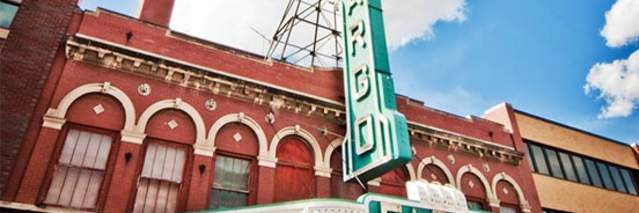About Fargo-Moorhead
Less than ten thousand years ago, the area that is now Fargo-Moorhead was 200 feet below the surface of Lake Agassiz, a huge inland sea formed at the end of the last iceage. Over centuries the waters receded, leaving six feet of rich, black soil that today make the Red River Valley one of the world’s most fertile farmlands, with Fargo and Moorhead as its center.
The Red River of the North separates the two cities and serves as the border between North Dakota and Minnesota. The city of Fargo was named for one of the owners of the Wells-Fargo Express Company, William G. Fargo. In 1885, the existence of many lawyers in Fargo and easy divorce laws prompted thousands of unhappy married people to apply for the “Ten-Minute Divorce.” Also in Fargo’s history is the Great Fire of 1893, started when Mrs. Rosa Herzman discarded ashes behind her grocery store. They were ignited, and fire spread from what is now Main Avenue to the north. By the end of the day, downtown Fargo was devastated.
The city of Moorhead was named after William G. Moorhead, an executive of the Northern Pacific Railway. In fact, the Northern Pacific Railway had a profound impact on both the economy and population of the area. Originally settled by Scandinavian and European immigrants, Fargo and Moorhead became boomtowns with the arrival of the NP in 1871. When the Northern Pacific Railroad was selecting its crossing site over the Red River, eager land speculators spared no effort to learn of the location. Railroad officials marked a false route a few miles north of Moorhead, Minnesota to throw speculators off the trail. This area, now Oakport Township, was known for years as “Bogusville.”
Under the Homestead Act, settlers were given 160 acres in exchange for living on the land and farming part of it for at least five years. Suddenly Fargo-Moorhead became a mecca for hopeful refugees from the overcrowded east. The railroad brought a constant stream of settlers seeking a new life on America’s newest frontier.
Today the population of the Fargo-Moorhead metropolitan area is more than 200,000, and there seems to be no end in sight to the persistent prosperity and growth of the twin cities on the Red. While agriculture is still prominent in the local economy, Fargo-Moorhead has also become an important focal point for other professions, including government, education, medicine, retailing and manufacturing.
The spirit of the early pioneers remains a treasured part of our proud heritage. We continue to build on our colorful past as we look forward to the promise of the future.
ABOUT FARGO-MOORHEAD
Fargo consists of three cities in two states – so it’s no wonder our reputation is a little off-kilter. In North Dakota, there’s Fargo (naturally) and West Fargo (which has the added distinction of being north and also “west” of normal). On the Minnesota side of the Red River, Moorhead propels our community beyond conventional boundaries. We owe a lot to our northern prairie locale. Our adventurous, pioneering spirit is alive and well. In our people, you’ll find a unique mix of Midwestern gregariousness and quiet strength. Ingenuity, vision and down-to-earth practicality define our distinct prairie soul.
INDUSTRY & AGRICULTURE
Located in the center of North America, the Red River Valley stretches over 30 miles, gently rising westward from the Red River, a north-flowing river running between North Dakota and Minnesota, and extending into Canada. Rich, black soil produces an abundance of crops such as potatoes, sunflowers, sugar beets, wheat, corn, soybeans, alfalfa, oats, and lentils. Industry and agriculture are closely related in Fargo-Moorhead. The area has meat packaging plants, sugar and sunflower processing plants, creameries and a malting barley plant.
The spirit of the early pioneers remains a treasured part of our proud heritage. We continue to build on our colorful past as we look forward to the promise of the future.
HISTORIC NEIGHBORHOODS
The upscale South 8th Street historic district has long been known as a high status neighborhood of people with political influence and business ties. The neighborhood has preserved its historic character with turn-of-the-century street lights, stately large elm trees, large, neatly landscaped yards, curved sidewalks and distinctive housing styles, including Colonial Revival, English Cottage, Dutch Colonial, Cube, Tudor and Mediterranean. The Northside district focused on Broadway, features large homes designed by architects such as the Hancock Brothers.
Contrary to the barren tundra you may have seen in FARGO the movie or TV show, Fargo is not bitterly cold all year long.
Sure, we get long, snowy winters like the rest of the places in these parts, but from April to October we get a short-but-sweet spring, hot summer (think 80-90 degree days on average), and a gorgeous autumn.
Weather in Fargo
Winter
| Average Winter High (°F/°C) | Average Winter Low (°F/°C) | |
| December | 22° / -6° | 6° / -15° |
| January | 18° / -8° | 0° / -18° |
| February | 24° / -5° | 6° / -15° |
| March | 36° / 3° | 19° / -7° |
Read more about winter in Fargo, ND.
Spring
| Average Spring High (°F/°C) | Average Spring Low (°F/°C) | |
| April | 56° / 13° | 33° / 1° |
| May | 69° / 21° | 45° / 7° |
Read more about signs of spring in Fargo, ND.
Summer
| Average Summer High (°F/°C) | Average Summer Low (°F/°C) | |
| June | 77° / 25° | 55° / 13° |
| July | 83° / 28° | 60° / 15° |
| August | 81° / 27° | 57° / 14° |
Read more about summer in Fargo, ND.
Fall
| Average Fall High (°F/°C) | Average Fall Low (°F/°C) | |
| September | 71° / 22° | 47° / 8° |
| October | 56° / 13° | 35° / 2° |
| November | 37° / 2° | 20° / -7° |
Read more about fall in Fargo, ND.
Looking to learn a little more about our cities? Check out the Fargo-Moorhead-West Fargo’s full Press Kit, or continue on reading for the gist of it.
HISTORY
WHAT’S IN A NAME
Fargo’s original name was Centralia, but was renamed after the Northern Pacific Railway director and Wells Fargo Express Company founder William G. Fargo.
Moorhead also garnered its name from a bigwig guy with the name William G. — in this case, William G. Moorhead, an executive of the Northern Pacific Railway.
During construction of the railway over the Red River, eager land speculators wanted to buy up the land and charge the railroad to use it. So, sneaky railroad officials marked a false route a few miles north of Moorhead to throw them off. This area, now Oakport Township, was known for years as “Bogusville.”
REALLY GOOD AT DIVORCES
In the 1880s, Fargo became known for its “10-Minute Divorce” as lax local laws allowed for quick and easy splits. Famous (and un-famous) people flocked to the city to get divorced.
WE DIDN’T START THE FIRE
On the afternoon of June 7, 1893, the worst fire in Fargo’s history — duly named the ‘Great Fire of 1893’ — destroyed the city. City hall, the business district, and the homes of most of Fargo’s 6,000 residents went up in flames, spreading from Front Street (now Main Avenue) to the north. 160 acres, 31 blocks, 219 businesses, and 140 residences were left in ashes. We’ve since learned not to build our entire city out of wood; you’ll notice most downtown businesses are now brick (and still standing!)
HANG YOUR HAT
Scandinavian and European immigrants settled the area and when Northern Pacific Railroad arrived in 1871, Fargo-Moorhead became a boomtown.
The Homestead Act furthered this boom as settlers were given 160 acres of land in exchange for living and farming it for at least five years. Hopeful refugees from the overcrowded east swarmed to the area, arriving in a constant stream on the railroad and looking for fresh starts on America’s newest frontier.
A CITY DIVIDED
The Red River of the North separates Fargo from Moorhead, also serving as the border between North Dakota and Minnesota — a visit here is an easy way to knock two states off your list.
INDUSTRY
SILICON PRAIRIE
While agriculture is still the main economic industry, professions like education, medicine, government and manufacturing play a large role in the city’s modern-day economy.
Surprisingly to some, Fargo also has a booming technology start-up industry that harnesses the spirit of the early pioneers. Fortune.com calls it ‘the most undervalued tech hub’ in America.
Major players like Myriad Mobile, CoSchedule, and Botlink dominate in the tech field, alongside niche market leaders like Weather Modification Inc. and Appareo Systems.
Giants in the area include Microsoft (which houses its second largest campus in the world in Fargo), Bobcat, Cass-Clay, and Titan Machinery.
A city of big ideas, Fargo is quickly becoming one of the top places to flock for young entrepreneurs according to Forbes, Fortune.com, and CNN Money (just to name a few). With an unemployment rate of 2.5%, we don’t blame them.
GEOGRAPHY
LIKE ATLANTIS…SORT OF
Less than 10,000 years ago, the area that is now Fargo-Moorhead was 200 feet below the surface of Lake Agassiz, a huge inland sea formed at the end of the last Ice Age.
Over centuries the waters receded, leaving six feet of rich, black soil that today make the Red River Valley one of the world’s most fertile farmlands, with Fargo-Moorhead at its center.
RED RIVER OF THE NORTH
Where the Bois de Sioux and Otter Tail rivers meet, the Red River of the North begins, winding upward for 550 miles before joining the Nelson River in Canada and ultimately spilling into Hudson Bay.
Flow direction: North
Average slope: ~½ ft per mile
Depth: 10-30 ft
Width: 100-500 ft
Color: brown due to the rich soils of the valley
WEATHER
Hot and breezy summers, arctic and snowy winters, about a month of fall, and two weeks of spring.
Averages:
Summer high: 83°F in July
Winter high: 18°F in January
Snow: 52 inches/year
Rain: 24 inches/year
Wind speed: Fast
Records
In 1988, the record high reached 106°F.
In 1982, the record low reached -38°F.
PHYSICAL DATA
Fargo-Moorhead-West Fargo metro population: 238,124
Area: 48.82 square miles
Terrain: Flat as a pancake
Wind: Oh yeah, you betcha
Located on the border of North Dakota and Minnesota.
A two hour drive from the Canadian border and 3 1/2 hours from Winnipeg, Manitoba.
GETTING HERE
TRANSPORTATION
PLANES
Hector International Airport has several direct flights and budget airlines that fly into and out of Fargo, making entry a breeze.
TRAINS
The passenger Amtrak trains have a stop right in Downtown Fargo, just a minute’s walk from many major sites like the Fargo Theatre.
AUTOMOBILES
At the intersection of two major interstates (I-29 and I-94), a stop in Fargo makes a great interlude to long journeys.




